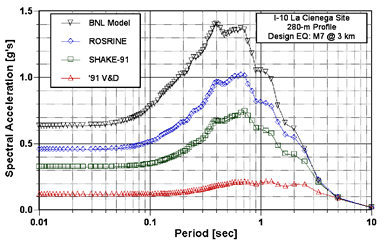| Project Title/ID Number |
Workshop on Uncertainties
in Nonlinear Soil Properties and Impact on Modeling Response—2B03 |
| Start/End Dates |
9/1/03 – 6/30/04 |
| Project Leader |
Michael Riemer (UCB/F) |
| Team Members |
Ellen Rathje (U.Texas/F), Donald
Anderson (CH2Mhill/I), Cliff Roblee (Caltrans/I), Lawrence Chiu (CSUS/O) |
F=faculty; GS=graduate student; US=undergraduate student; PD=post-doc; I=industrial
collaborator; O=other
Click on images to enlarge in a new window
1. Project Goals/Objectives:
This project supplements funding for an NSF Workshop focusing on identifying
the key sources of uncertainty surrounding the non-linear dynamic properties
of soils, and evaluating the role of this uncertainty in the context of
other factors in performing Site Response Analysis (SRA).
The primary goals
of the project are:
-
Direction to the profession on the need to reduce the
level of uncertainty and bias in nonlinear soil property determination,
and if there is a need,
the types of testing or modeling that best address these issues.
-
A better
understanding of the current and future needs for soil modeling, and how
these needs are related to the prediction of ground response and
soil-structure interaction.
-
A consensus between the Testers and Modelers
on the types of development that should occur in each of their respective
areas.
-
Guidance to funding agencies on areas of research that are likely
to achieve the most progress in the overall area of soil response and
soil-structure interaction modeling.
It is well established that uncertainties
exist in nonlinear soil property determination. These uncertainties result
from a number of sources, including
inherent variations in nonlinear soil properties, soil sample disturbance,
equipment testing effects, and in situ stress state/stress history.
There are also a variety of soil models in use for predicting site effects,
which can lead to substantial variation in predicted motions in some
cases (see
Figure 1).

Fig. 1 - Predicted spectra using different soil models at a deep soil
site (after Silva, 1998)
2.
Role of this project in supporting PEER’s mission
(vision):
An improved understanding of the relative uncertainties in site response
analyses is crucial to the PBEE methodology, since the variability of
the seismic demand is a dominant sources of uncertainty in many hazard
analyses.
3. Methodology Employed:
A key element to the Workshop is to bring together experts from different
backgrounds that occupy different roles in the process of predicting
seismic ground response. These include Testers, who measure the non-linear
soil properties themselves (both in the lab and the field); Constitutive
Modelers, who incorporate such properties into their models; Numerical
Modelers, who develop the tools used to perform SRA; and Engineering
Practitioners, who ultimately apply the tools developed by others to
evaluate likely ground motions for specific projects. While there is
some overlap among individuals in these groups, there is a clear lack
of exchange among the different groups as a whole in terms of identifying
common priorities, and insuring that research conducted in one area can
be cleanly “handed off” to the others for direct application
in reducing the uncertainties.
The structure of the Workshop was developed
to both leverage the specific expertise within each group, and provide
formal opportunities for individuals
to interact through “cross-cutting” breakout sessions.
4. Brief Description of past year’s accomplishments
(Year 6) & more detail on expected Year 7 accomplishments:
The organizing committee for the Workshop was active through frequent teleconference
calls to identify appropriate speakers and other Workshop participants,
develop and revise the agenda to best meet the goals of the Workshop, and
prepare the participants through solicitation and posting of preliminary
materials on the Project web site.
The Workshop itself was held on March
18 and 19, 2004, at the PEER Center in Richmond, and was attended by some
44 participants from around the world,
include three from overseas.
5. Other Similar Work Being Conducted Within and Outside
PEER and How This Project Differs:
PEER Lifelines Project 2B01/02 involved extensive testing of high quality
soil samples obtained as part of the ROSRINE program in Southern California.
As such, it provided direct comparisons of dynamic properties as determined
through Resonant Column, Torsional Shear, and Double Specimen Direct Simple
Shear testing methods. While this provided some measure of the variability
in properties associated with different methods, the current Workshop establishes
a framework for evaluating the importance of these variabilities, particularly
in comparison with other sources of uncertainty (eg. the input ground motion,
and the simplifications inherent in constitutive and numerical models for
site response).
6. Plans for Year 8 if project is expected to be continued:
Not applicable.
7. Describe any actual instances where you are aware your
results have been used in industry:
As the Workshop is primarily concerned with identifying key issues for
quantifying sources of uncertainty and key areas for further research,
there are not yet specific cases in practice that have been impacted. However,
it is important to note that the inclusion of practicing engineers in the
Workshop formed an important “reality check” on the ideas proposed
by researchers at the workshop, while also establishing a direct path by
which future developments can be incorporated by these individuals in industry.
8. Expected Milestones & Deliverables:
-
-
Proceedings of the Workshop, including presentations and summaries of
breakout sessions, plenary discussions, and consensus research priorities
will be
posted to the same site during April 2004.
